Cisco Extended Enterprise SD-WAN with IR1101 Solution Overview
Available Languages
Bias-Free Language
The documentation set for this product strives to use bias-free language. For the purposes of this documentation set, bias-free is defined as language that does not imply discrimination based on age, disability, gender, racial identity, ethnic identity, sexual orientation, socioeconomic status, and intersectionality. Exceptions may be present in the documentation due to language that is hardcoded in the user interfaces of the product software, language used based on RFP documentation, or language that is used by a referenced third-party product. Learn more about how Cisco is using Inclusive Language.
Securely extend IT’s reach to noncarpeted spaces
The Cisco® Extended Enterprise SD-WAN solution with the Cisco 1101 Industrial Integrated Services Router Rugged (IR1101) offers a simplified ability to route traffic from noncarpeted spaces in a secure manner with a consistent quality of experience scalable up to 500 tenants and 10,000 devices. The solution brings Cisco’s market-leading Industrial Router (IR1101) and SD-WAN architecture (Cisco vManage) all the way to the Internet of Things (IoT) edge. This document provides IT audiences a high-level overview of the use cases, business outcomes, solution architecture, and building blocks of Cisco Extended Enterprise SD-WAN.
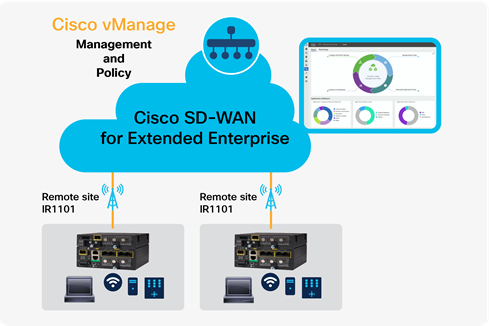
Cisco Extended Enterprise SD-WAN with IR1101
By connecting noncarpeted spaces to your core IT managed networks, the extended enterprise solution can help drive business outcomes such as:
● Reduced cost: Lower WAN OpEx and CapEx while maintaining or even improving existing SLAs; manage the entire enterprise network centrally to reduce overall networking and IT infrastructure cost
● Agility: Quickly deploy new services and applications throughout the WAN network
● Flexibility: Leverage the best available network connection to provide access to traditional data centers as well as cloud environments
● Security and control: Provide secure operations and gain insight into the use of the services offered on the WAN
● New experiences: Enable new digital experiences for your customers and increase customer satisfaction
Sensors, cameras, and other smart devices are fueling opportunities to extend digitization into entirely new parts of a business. These investments can support business process transformation, enhanced operational efficiency, and better, more personalized experiences for customers and employees. But they require IT teams to enable secure connectivity to thousands of miles of remotely located assets to be managed alongside the existing IT WAN networks. https://www.cisco.com/go/extendedenterprise
Remote point of sale
With the advent of cloud computing, cloud-based Point-Of-Sale (POS) systems serve businesses across energy, utility, retail, wholesale, healthcare, hospitality, and sports industries. Many companies would like to set up remote POS systems in several locations for their customers to make payments. At the authorized payment location, customers can conveniently pay using several different forms of payment. Due to the complete dependence of site operations on WAN connectivity, these remote POS systems require redundant WAN links (LTE/Internet) connected to the enterprise backhaul.
However, the remote POS systems need ruggedized networking products because they are often in areas that are dusty, damp, or without air-conditioning. For such harsh environments, ruggedized SD-WAN-compatible WAN routers, such as the Cisco IR1101 with redundant WAN connectivity, are a preferred choice.
Secure direct Internet access for remote sites
Today, Direct Internet Access (DIA) is much less expensive than traditional Multiprotocol Label Switching (MPLS) and leased lines. With many applications moving to cloud, it makes all the more sense to reach out to the cloud applications with a local Internet breakout (DIA) rather than using a traditional centralized data center approach for enterprise Internet connectivity. Another prominent use case is site-to-site mesh connectivity between remote sites. All these create a need for additional security at the branch office and a policy-based centralized WAN management model. Other needs for these remote sites and branches are redundant LTE WAN links over secure private APNs.
Often these remote sites are located in noncarpeted spaces. The Cisco IR1101, a ruggedized SD-WAN-compatible WAN router, is the default choice for such extended enterprise deployments.
Warehouses and distribution centers
Many companies have warehouses and distribution centers spread across the globe. Often located in remote locations, these need redundant and secure mesh WAN connectivity between them.
The harsh environmental conditions at these sites, and the need for policy-driven interconnect options and redundant LTE WAN connectivity, make the Cisco IR1101 highly suitable for secure connectivity.
Extended Enterprise SD-WAN solution features and benefits
The Cisco 1101 Industrial Integrated Services Router Rugged, or IR1101, is Cisco’s smallest industrial router. Designed in a highly modular form factor, it is an ideal solution for many enterprise IT teams to quickly deploy and manage with their existing Cisco vManage SD-WAN solution.
The Cisco IR1101 enables concurrent connectivity to two cellular networks for WAN redundancy, enhanced data throughputs, load balancing, and differentiated services, making it a highly reliable and high-performance platform. It is also SD-WAN capable to enable high WAN availability and simplicity for large-scale extended enterprise distributed networks.
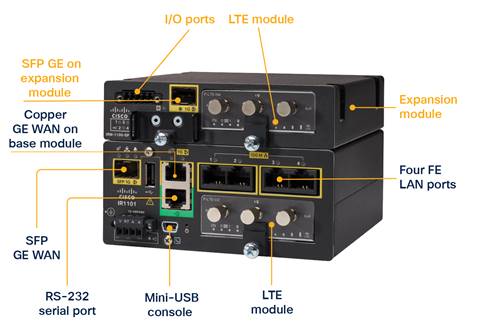
Cisco IR1101
Table 1. Features and benefits
| Solution features |
Benefits |
| Dual LTE, dual SIM, private APN |
WAN redundancy, high availability |
| Cisco vManage as a single pane of glass for managing SD-WAN use cases across carpeted and noncarpeted spaces |
Simpler to manage, security and compliance with policies; scalable and repeatable operations across the entire enterprise |
| Fanless, -40°to +75°C (-40°to +167°F), self-cooled with industry certifications |
Purpose-built for harsh environments to handle shock, vibration, and extreme temperatures |
| Ease of deployment with Plug and Play |
Lower TCO; fast and easy bring-up |
| Modular LTE and 5G; ready for future |
Compact form factor (2RU); expansion modules for more interfaces; investment protection; extended product lifetime |
| A mix of MPLS and low-cost broadband or any combination of transports in an active/ active fashion |
Reduced bandwidth costs; optimized capacity; hub and spoke and mesh topologies |
Cisco Validated Designs
Cisco Validated Designs (CVDs) have been created to validate, architect, and configure next-generation technologies. Each is designed to help you accelerate digital transformation, innovate faster, and stay competitive. The Extended Enterprise SD-WAN CVD is no exception. It provides a design foundation for incorporating a broad set of technologies, features, and applications. Every aspect has been thoroughly tested and documented, helping ensure a deployment that’s fast, reliable, cost-effective, and predictable.
Value proposition of the Extended Enterprise SD-WAN CVD
Planning, testing, and implementing various components and shared services for an extended network on your own can pose a large challenge for organizations. By using the Extended Enterprise SD-WAN CVD with a modular approach—which tests and validates the foundation infrastructure, security, automation, assurance, and shared services—you can reduce costs, risks, and operational issues, as well as increase deployment speed.
Here are some of the many ways an organization can benefit by deploying the Extended Enterprise SD-WAN CVD:
● By using Cisco validated reference designs to deploy a very small, small, medium, or large Extended Enterprise SD-WAN network to remote noncarpeted locations
● By gaining simplicity through a single pane of glass for SD-WAN use cases for carpeted and noncarpeted spaces with Cisco vManage
● By reducing the cost of deployment with plug-and-play design guidance for deploying and managing Cisco IR1101 devices using Cisco SD-WAN
● By designing centralized security policies using the Cisco SD-WAN solution
● By adding scalability, high availability, and reliability in noncarpeted spaces for resilient operations
● By choosing summarized and simplified designs to accelerate deployment and operation of the extended network
Extended Enterprise SD-WAN CVD
The extended enterprise landscape is continuously evolving. There is a greater demand for mobile and IoT device traffic, Software-as-a-Service (SaaS) applications, and cloud adoption. In addition, security needs are increasing, and applications require more prioritization and optimization. As this complexity grows, there is a push to reduce costs and operating expenses. High availability and scale continue to be important.
Legacy WAN architectures are facing major challenges under this evolving landscape. These architectures typically consist of multiple MPLS transports, or an MPLS paired with an Internet or LTE used in an active/backup fashion, most often with Internet or Software-as-a-Service (SaaS) traffic being backhauled to a central data center or regional hub for Internet access. Issues with these architectures include insufficient bandwidth along with high bandwidth costs, application downtime, poor SaaS performance, complex operations, complex workflows for cloud connectivity, long deployment times and policy changes, limited application visibility, and difficulty in securing the network.
Cisco vManage is a single-pane-of glass solution for day-0, day-1, and day-2 operations. It is highly scalable with multitenant capability. It provides a user-friendly GUI interface for configuring and deploying policies and templates.
vManage is multitenant, delivered via the cloud or on-premises, highly automated, secure, scalable, and application-aware with rich analytics.
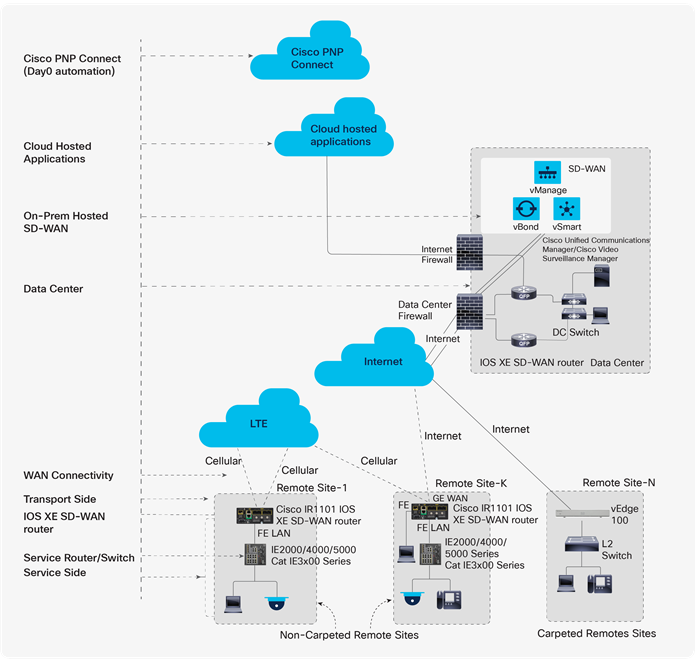
Cisco vManage
The Extended Enterprise SD-WAN CVD outlines the steps for both IT and operations teams to accomplish business goals by digitizing operations in ruggedized spaces. It includes design guidance for implementing extended enterprise use cases with an existing Cisco vManage deployment.
The Extended Enterprise SD-WAN CVD provides a step-by-step reference design and deployment guidance for extending the enterprise network with the Cisco SD-WAN and IR1101 to remote noncarpeted locations. The design guidance caters to a broad set of customer use case deployment scenarios.
Table 2. Deployment scale of the Extended Enterprise SD-WAN CVD
| Deployment scale |
Very small |
Small |
Medium |
Large |
| Number of endpoint devices |
Up to 4 |
5 to 8 |
More than 8 |
More than 8 |
| WAN dependency |
High |
High |
Very high |
Very high |
| LAN switch redundancy |
No LAN switch |
No redundancy |
No redundancy |
Redundant |
Very small remote sites (example: ATM booth)
Designed for sites such as ATM booth and unmanned payment centers, the very small site design enables a very small service-side network of up to four devices with dual LTEs and service-side redundancy.
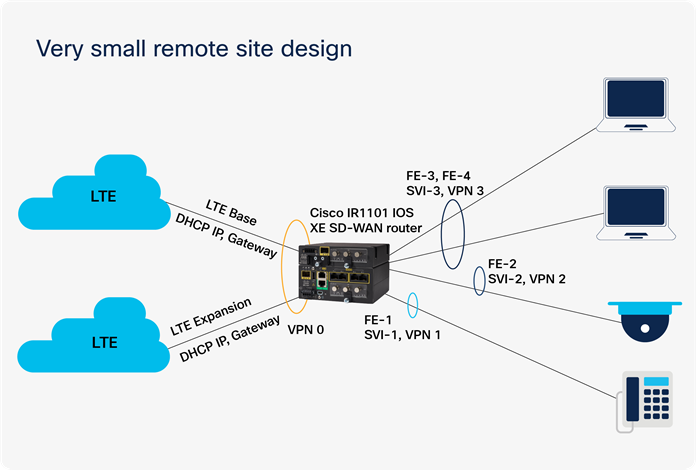
Very small site design
Small sites (example: kiosks)
Designed for remote sites such as kiosks and manned payment centers, small site designs are configured with a single WAN router, dual LTEs, and a service-side switch.
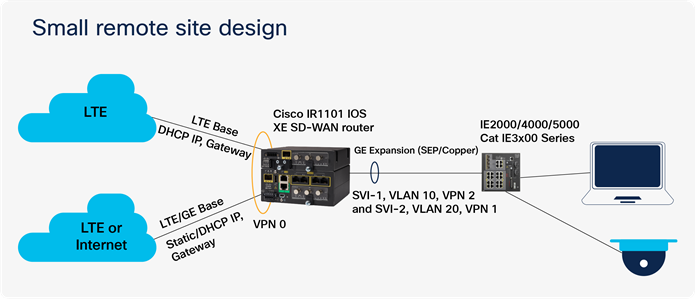
Small site design
Medium sites (examples: warehouses, distribution centers)
These are remote sites such as remote warehouses and distribution centers that require more than eight endpoints and a very high level of WAN dependency. Unequal-cost load balancing to prefer the WAN router with the desired WAN link (based on cost, bandwidth) is a consideration.
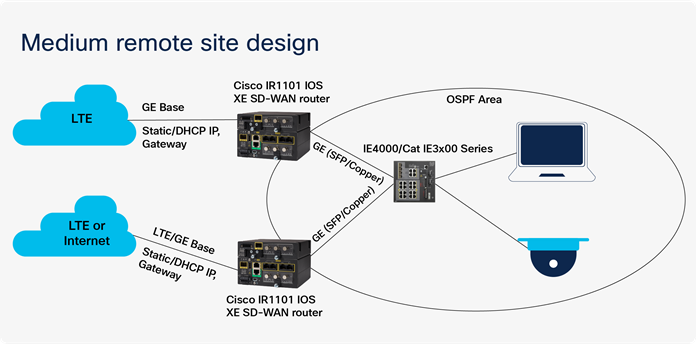
Medium site design
Large remote sites (examples: large warehouses, distribution centers)
Remote sites with more than eight endpoints, having a very high level of WAN dependency and high business criticality, are classified as large sites. Typical examples of a large remote site are large warehouses and large distribution centers.
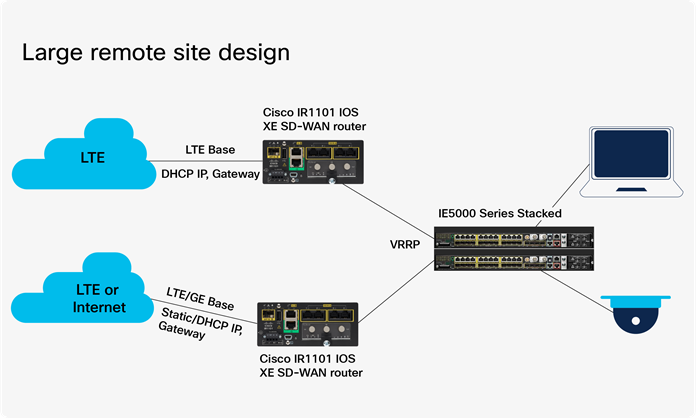
Large remote site design
In today’s world, the network connects everything. It has the potential to constantly adapt, protect, and inform across all IT and business processes. Cisco’s intent-based network is an architecture based on automation and analytics to deliver policy from end to end at scale. The intent-based network enables customers to capture business intent and activate it networkwide, in the campus and in noncarpeted spaces where the operations happen. Unique Cisco differentiators to extend your enterprise:
● Cisco’s Industrial Ethernet portfolio is number 1 in the managed industrial switching market; Cisco is also the market leader in SD-WAN infrastructure
● Our industrial networking products bring intent-based networking all the way to the IoT edge, with a rich, industry-standard Cisco IOS® Software feature set
● Costs are reduced by extending centralized operations to outdoor and noncarpeted spaces using Cisco vManage
● End-to-end security and consistent policy extend across the carpeted and noncarpeted spaces of an enterprise
● Cisco offers a complete portfolio across Industrial Ethernet, routing, and wireless
Access our Extended Enterprise SD-WAN CVD
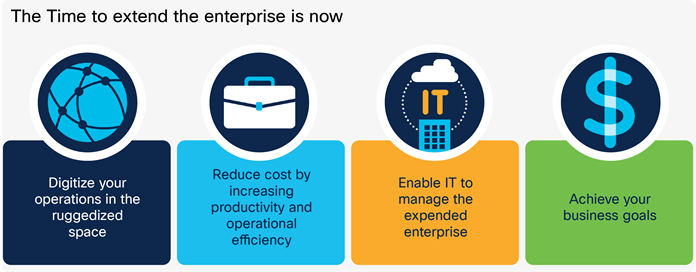
You can access our CVD by visiting the Extended Enterprise site: https://www.cisco.com/go/extendedenterprise or https://www.cisco.com/go/iotcvd.